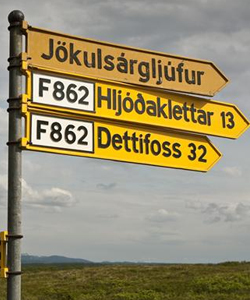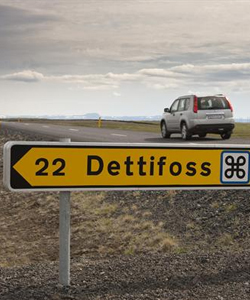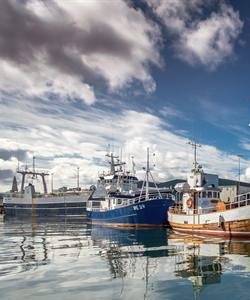
Transportation
Getting here
Since Iceland is an island in the middle of the Atlantic Ocean the only means of getting here are plane and boat.
By far the majority of Iceland's visitors arrive by plane. The country's only international airport is almost always referred to as Keflavik airport (KEF) although it's real name is “Leifur Eiríksson International”. If you want to distinguish yourself from the mass of the other tourists pronounce Keflafik the correct Icelandic way, that's to say make the "f" a "p": Keplavik.
The airport is situated at about 45 km south east of Reykjavik on the peninsula of Reykjanes. There are direct flights from almost every European country and an increasing number of flights from the United States operated by different airlines.
Domestic flights in Iceland are entirely in the hands of Air Iceland. They also operate flights to Greenland and the Faeroe Islands. All depart from the small domestic airport next to Reykjavik's city centre.
From Reykjavik there are daily connections to Akureyri, Bíldadur, Egilsstaðir, Gjögur, Ísafjöður, Sauðárkrókur, the Westman Islands and Höfn. From Akureyri, Iceland's second largest city, there are connections to Grímsey, Vopnafjöður and Þórshöfn.
Flying is often cheaper than taking the bus. A one hour one way flight from Reykjavik to Egilsstaðir for example costs around 90 Euro, less if you buy it some time in advance.
If you don't like flying you can reach Iceland as well by boat. There are regular ferries form Denmark, Norway, from the Feroe Islands and the Shetland Islands. All ferries arrive in Seyðisfjörður, in the very East of the country.
Local ferries serve the inhabited islands around Iceland like the Vestmann Islands, Hrisey (in the Eyjafjödur, in the North) or Grimsey. Grimsey, by the way, is a tiny island 40 km north of the Icelandic mainland. Its attraction: it's northern tip stretching just over the magic 66° latitude mark making it the only place in Iceland where you can set foot on (or even cross) the Arctic Circle.

Getting around
The main means of transport in Iceland is the car, for locals and tourists alike. Almost everybody in the country owns a car, a lot of places on the countryside as well as in the cities are only accessible if you have one.
But Iceland also has a well working public transportation system, especially in the urban areas of the bigger cities like Reykjavik and Akureyri. There are also overland buses connecting the main villages and tourist sites around the island. Itineraries are largely restricted to the Ring Road, though, and service frequency is reduced notably outside the summer months (from September until May).

Driving in Iceland – an overview
There are few countries in the world that lend themselves so well for travelling by car like Iceland does. Of course not each and every part of the island is accessible by road (that would spoil the whole “rough, wild and remote” charm, won't it?) but many of the country's spectacular sites still are easily accessible. And driving in Iceland is fun! Renting a car is thus a very good idea for your Icelandic holidays.
For a start there is Iceland's famous Ring Road (Hringvegur). On 1.337 km it goes one time around the island, connecting the most important cities: Reykjavik in the West, Akureyri in the North, Eigilstaðir in the East and Höfn in the South. The Ring Road is one of the few 35% of Icelandic roads that is entirely sealed (apart from a very small unpaved stretch in the East...).

The ring has been closed as late as in the mid-seventies. Still there's constant construction work going on, mostly with the aim to cut long, winding shore stretches short by building tunnels and bridges. The construction of the Hvalfjord tunnel between Reykjavik and Akranes in the West for example shortened the ring road by 60 km, saving travellers about 1,5 hours of driving.
The Ring Road is Iceland's economic and social aorta and consequently well maintained, including the effort to keep it free of snow during winter times.
Even in the peak season in the summer and on the most frequented parts in the South the traffic on the Ring Road is far from what most people are used to in there home countries. Adding the speed limit of 90 km/h (the general speed limit for sealed roads in Iceland) makes it a pleasant and for almost the entire length spectacularly scenic drive!
The road is apt for all kinds of vehicles from small compact cars to mobile homes and trucks.
Driving on the Ring Road as well as on all other Icelandic roads is free of road charge (except for using the already named (privately owned) tunnel under the Hvalfjord).
65% of Iceland's roads are not sealed. Some are very well build and maintained, driving as nice and easy as on their sealed sisters. But then there are the „mogul pists“ with more holes than even ground, the denomination „road“ being clearly an euphemism.
For driving here you better change to a 4-wheel-drive.
On many of those roads, mostly in the interior, 4WDs are actually a must. Those roads are marked on the map with an F in front of the road number and with a sign where they start (see picture). „Illfær vegur” in this case translates to „bad road“. Icelandic road signs are almost always in Icelandic, being one of the reason for tourists getting themselves into (avoidable) danger. A task force has been established to make road signs more international. With ambiguous success so far. The new sign reading „impassable“, for example, provoked a spontaneous: „Haha, the Icelanders can't write proper English. They mean ImpOssible!“ Also among native speakers...
The truly tricky thing about F-roads is not so much the condition of the road, though, but the river crossings it usually involves.
Rivers in Iceland are abundant. Some are spanned with bridges, especially on sealed and frequented roads like the Ring Road. Bridges are almost always one-lane – saving the state money and material. No problem usually, given the traffic's (non existent) density. Nevertheless, make sure no one's entering the bridge from the other side before you go.
By far the majority of the rivers, though, has to be forded. To ford a river is a risky enterprise, even for a local with experience and a Super Jeep. Rivers are living organisms, prone to turn from a harmless creek into a roaring monster in a couple of hours. Especially glacier rivers are moody and furthermore tend to carry rocks and blocks of ice.
If not otherwise marked on the map rivers on official roads should be able to be crossed with a proper 4WD. And the right technique, of course. Cross the river slowly, in the first gear. Entering it with speed will create a front wave that might end up where you don't want it, e.g. in your exhaust pipe. Over and out.

There are some river crossings that right from the start require a vehicle more A-Team style than a common 4WD pimped compact car. Those rivers are marked with a cross on the map.
Be aware that, while renting a car, there is no “getting-stuck-in-a-river-insurance”. If you get stuck you will have to bear the costs of the car's (and your) rescue. So: don't.
Beside the river crossings (and some occasional storms...) the biggest challenge you encounter while driving in Iceland are: sheep.
During the summer months sheep (and also horses and cattle) roam freely in the countryside. As often as there are fences close to roads as often there are not. Always slow down when sighting a group of cuddly white balls with eyes and sticky legs ahead, more so when some of them happen to be on the left and some on the right side of the road. The probability that either group starts running towards the other as soon as they realize that you are coming near is, well, high (the sheep realize it very, very late, by the way. As cute as dumb...).
As pleasant as driving is in Iceland during the summer it becomes a challenge in winter.
Ice and snow make winter tires with spikes a must, in fact it's obligatory for all cars from November until May. If you should wonder how it's possible that most of Reykjavik's streets stay free of snow and ice while the rest of the country remains sunk into winter's adamant white grip, well..., the streets are heated.
A waste of precious water and energy? In your country maybe. Not here. If Iceland has one thing in abundance (and thus to waste) it's (volcanic heated) water and energy (derived from it).

Traffic rules
As mentioned above the maximum speed limit on sealed roads is 90 km/h. On unsealed roads it's 80 km/h. The speed limit in cities is a common 30-50 km/h.
You better stick to the limits. It's an easy and welcomed money flow into the (since the crisis notoriously empty) governmental pockets to position controls at strategic points along the Ring Road, more so during the busy summer months. You get a discount, by the way, if you pay on site. Don't worry about not having the right amount in cash with you: the traffic police takes credit cards.
Speaking of fines: you better also abstain yourself from drink-and-drive adventures. Icelandic policy regarding alcohol behind the wheel is: 0,05%. Violating this will lighten your pocket by 70.000 ISK (approx. 450 €) as well as deprive you of your driver's licence - for at least two month.
Although driving one of those highly pimped (super) Jeeps the idea admittedly is tempting don't venture off the marked roads. It will be fined as well.
Most of the other Icelandic traffic regulations will probably ring a bell:
- You need a valid driving licence (surprise, surprise...). The one you obtained in your home country does the deed. Only if you plan to stay in Iceland longer, that's to say change your legal domicile, you will have to exchange your licence for a proper Icelandic one.
- Car driving in general is permitted in Iceland from the age of 18 onwards. To be entitled to rent a car, though, you have to be at least 21, even 25 if you go for a 4WD.
- No drive-and-cell-phoning! (unless with a hands-free-kit).
- Children under 6 years need to be put into a special children's seat, children under 12 in the back (the same law applying for people weighing less than 40 kilos or being smaller than 1,40m by the way...).
- Like in most Scandinavian countries the car's head lights have to be turned on year round at any given time of the day (not just during darkness/night time). In most Icelandic cars the lights switch on automatically when you start the engine but you better check.
- It's mandatory to drive with the seatbelt fastened, everybody in the car. Also in (public) buses.
- All cars in use have to have an insurance and a valid vehicle inspection certificate.

Car rental in Iceland – tips on which insurances to buy
The standard (and mandatory) insurance is the so called Collision Damage Waiver (CDW). In case of an accident caused by you it covers the damages on your and all other involved cars. It usually comes with a (variable) franchise which is the amount you have to pay yourself, the insurance covers the rest. The lower the franchise the higher the insurance fee. Obviously.
In Iceland it can be wise to opt for Gravel Protection (GP). The GP covers damages to the front and back screens of the car caused by flying stones. Even if gravel roads are outside your planned itinerary be aware that also sealed roads are never completely free of stones. A car passing at high speed can easily send whatever's under its tires flying towards you and your vehicle. Fixing damages to the screens means exchanging them meaning: expensive.

The Theft Protection you can probably leave aside. There are always exceptions to the rule but Iceland is probably one of the most secure countries in the world. Besides, stealing a car on an island is not a very clever idea. Where shall it go? Theft Protection, by the way, doesn't mean that the value of the car itself is covered. The insurance covers the damages that the stolen car invokes on other cars.
Some car rental companies offer Sand & Ash Protection. Well. We can't full heartedly say: go for it, but neither: forget about it, it's ridiculous, something for the overly fearsome.
There are volcanoes in Iceland and there is a lot of ash, always, also when there is no eruption at the moment. Ash will cause the engine to suffocate. Can happen.
And there is also: sand. And: wind. A lot of wind. A lot, a lot, a lot of wind. Sometimes. Have you ever seen a car after a sand storm? It's been quite probably been neatly cleaned of each and every inch of varnish on the exposed side. Natural sand-blast.
Up to you.

Security tips
To close the topic some (seriously meant) survival tips before setting off with a car towards the wild:
- tell someone where you are going
- always take a good road map with you
- check the weather forecast for the part of the country you are travelling in (for example on http://en.vedur.is/ )
- in case you have to spend the night, take:
- enough water
- food!
- blankets/sleeping bag
- extra warm cloths
- flash lights (when you go late in summer or in winter)
- make sure your cell phones are charged
- in case of emergency call 112. In Iceland there is just one number for police, ambulance and everything else.